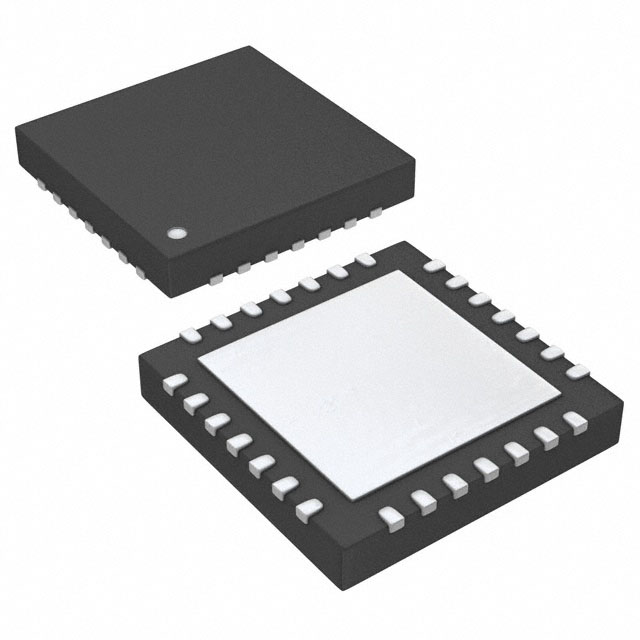Viz Specifikace pro podrobnosti o produktu.

MCP23S17-E/ML
Product Category
The MCP23S17-E/ML belongs to the category of integrated circuits (ICs) and specifically falls under the family of I/O expanders.
Basic Information Overview
- Use: The MCP23S17-E/ML is used as an I/O expander, providing additional input/output ports for microcontrollers or other digital systems.
- Characteristics: It features a SPI interface, 16 I/O pins, and programmable interrupt capability.
- Package: The MCP23S17-E/ML comes in a 28-pin SSOP package.
- Essence: Its essence lies in expanding the I/O capabilities of microcontrollers and digital systems.
- Packaging/Quantity: Typically packaged in reels with a quantity of 2500 units per reel.
Specifications
- Operating Voltage: 1.8V to 5.5V
- Maximum Frequency: 10 MHz
- I/O Pins: 16
- Interrupt Output Pins: 2
- Package Type: SSOP-28
Detailed Pin Configuration
The MCP23S17-E/ML features a total of 28 pins, including power supply, ground, SPI communication pins, and the 16 I/O pins. A detailed pinout diagram can be found in the product datasheet.
Functional Features
- SPI Interface: Allows for easy communication with microcontrollers and other devices.
- Configurable I/O: Each I/O pin can be individually configured as input or output.
- Interrupt Capability: Supports interrupt-on-change for each I/O pin.
Advantages and Disadvantages
- Advantages:
- Expandable I/O capabilities without consuming additional microcontroller pins.
- Configurable interrupt functionality enhances system responsiveness.
- Wide operating voltage range allows for versatile applications.
- Disadvantages:
- Requires understanding of SPI communication protocol for effective use.
- Limited to 16 I/O pins, which may not suffice for larger-scale projects.
Working Principles
The MCP23S17-E/ML operates by interfacing with a microcontroller or digital system through the SPI protocol. It provides a seamless way to expand the I/O capabilities of the host system, allowing for increased flexibility in connecting and controlling external devices.
Detailed Application Field Plans
The MCP23S17-E/ML finds application in various fields such as: - Embedded Systems: Used to expand I/O capabilities in embedded projects. - Industrial Automation: Enables control and monitoring of multiple devices in industrial settings. - Consumer Electronics: Incorporation into products requiring additional I/O ports, such as smart home devices.
Detailed and Complete Alternative Models
- MCP23017: Offers similar I/O expansion capabilities but communicates over I2C instead of SPI.
- PCF8574: Another I/O expander with I2C interface, suitable for applications where SPI is not available.
In conclusion, the MCP23S17-E/ML serves as a versatile I/O expander with SPI interface, offering configurable I/O pins and interrupt capabilities. Its wide operating voltage range and compact SSOP package make it suitable for diverse applications in embedded systems, industrial automation, and consumer electronics.
Word count: 410
Seznam 10 běžných otázek a odpovědí souvisejících s aplikací MCP23S17-E/ML v technických řešeních
Question: What is MCP23S17-E/ML?
Answer: MCP23S17-E/ML is a 16-bit I/O expander with SPI interface.Question: What is the operating voltage range of MCP23S17-E/ML?
Answer: The operating voltage range is 1.8V to 5.5V.Question: How many I/O pins does MCP23S17-E/ML have?
Answer: It has 16 I/O pins.Question: Can MCP23S17-E/ML be used for both input and output operations?
Answer: Yes, it can be configured for both input and output.Question: What is the maximum SPI clock frequency supported by MCP23S17-E/ML?
Answer: The maximum SPI clock frequency is 10 MHz.Question: Is MCP23S17-E/ML suitable for use in industrial applications?
Answer: Yes, it is suitable for industrial applications due to its wide operating voltage range and robust design.Question: Can multiple MCP23S17-E/ML devices be daisy-chained together?
Answer: Yes, multiple devices can be daisy-chained for expanded I/O capabilities.Question: What are the typical applications of MCP23S17-E/ML?
Answer: Typical applications include interfacing with microcontrollers, LED control, keypad scanning, and more.Question: Does MCP23S17-E/ML have built-in pull-up resistors?
Answer: Yes, it has programmable pull-up resistors for each I/O pin.Question: Is there a development kit available for MCP23S17-E/ML?
Answer: Yes, there are development kits and evaluation boards available for easy prototyping and testing.

